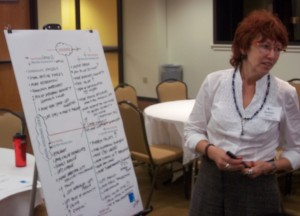Parkside: West Park residents voice opinions at Philadelphia 2035 planning meeting

Sonia Laron discussed the positives and negatives of more parking versus more pedestrian accommodations in the West Park neighborhood.
Members of Parkside and surrounding neighborhoods gathered Tuesday at St. Joseph’s University for the second public district plan meeting for the Philadelphia 2035 project — the first comprehensive plan for the city since the ’60s. West Park, along with the Lower South, is one of two district plans to be completed this year.
The project itself is twofold: the citywide comprehensive plan, which reaches 25 years into the city’s future, and 18 individual district plans. The meeting had nearly 50 attendees and helped the CPC gather input from residents on topics ranging from housing and pedestrian walkability, to cultural institutions and the role they play in the neighborhood.
“The three main areas we’ve been floating around focusing on are the Centennial District, 52nd Street and City Ave[nue],” said Andrew Meloney, the community planner and project manager for the West Park plan. “This is an opportunity for real feedback on those ideas.”
Andrew Meloney, project manager for the West Park district, gave a brief overview of the evening’s discussion.
Before breaking into smaller groups, Meloney called on the group to set the “tone” of the plan. “Will we be cautious? Optimistic?,” he asked. He explained that by suggesting seemingly opposite ideas he hoped that they would arrive at solutions that cross boundaries, weighing pros and cons of possible planning initiatives by asking “what would life be like if…” in many different scenarios.
Residents resonated opinions on many issues, but parking and lack thereof was a major one. Discussions revolved around how to best suit parking needs while still allowing for pedestrian traffic, which was of great importance to many. Creating scenarios with more or less cars or pedestrians, group members envisioned the outcome of each and then voted on which would be ideal. Garage parking and wider streets were two possibilities suggested.
In the neighborhood home to the Please Touch Museum and Philadelphia Zoo, many discussed the role that these places play for community residents. Traffic was especially noted as an issue in these areas, and the tole that tourist traffic takes on residents was vocalized.
Donna Carney from the City Planning Commission recorded a group’s conversation about housing.
“The cultural attractions need to be more open to the community,” Sonia Laron suggested. Another group member added that while there is great value in cultural attractions, they need to be more affordable and accessible to its neighbors. Others felt that more commercial zoning near these institutions would allow the neighborhood to capitalize on visitors.
“Hopefully we can get people to open up and create a dialogue with this more less thing and get some feedback we can use,” Meloney said. “People are pretty opinionated but we want to ask what can you do to balance [these ideas]?”
Contact the reporters at fisher.christine@temple.edu or kara.savidge@gmail.com
WHYY is your source for fact-based, in-depth journalism and information. As a nonprofit organization, we rely on financial support from readers like you. Please give today.



